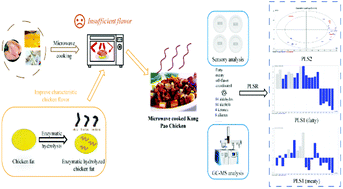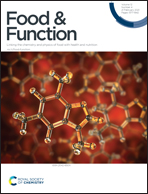Flavor and texture characteristics of microwave-cooked Kung Pao Chicken by different heat conduction effects and further aroma improvement with moderate enzymatic hydrolyzed chicken fat†
Abstract
Ceramic dish cooking method (CDCM) and microwave absorption dish cooking method (MADCM) were used to obtain one-step microwave-cooked Kung Pao Chicken. Processing the optimization of recipes, steaming time and microwave time was conducted for microwave cooking methods. CDCM showed higher taste scores, better umami and sweet attributes, and better color and aroma than MADCM. The NMR and FITC fluorescence analysis results indicated that free water in chicken cooked by CDCM was lost more and tends to shift to immobilized water during the microwave heating as compared with MADCM. However, the aroma intensity by CDCM was weaker than the traditional cooking method (TCM). Electronic nose analysis also showed difference in the flavor profile from CDCM and TCM. According to the GC-MS analysis, aldehydes, the oxidation products of fats, were higher from TCM than from other cooking methods. Therefore, enzymatic hydrolyzed chicken fat at 5 g per 150 g chicken with a degree of enzymatic hydrolysis of 17.00% was used in CDCM to produce ideal fatty and meaty flavor. Both fatty and meaty flavor have increased by 52% and 60% respectively, with less off-flavor, thus, obtaining a similarity of 92% compared to TCM and with appropriate contents of volatiles such as hexanal, heptanal, (E)-2-octenal, (E)-2-decenal, (E)-2-nonenal and 2,4-decadienal.



 Please wait while we load your content...
Please wait while we load your content...